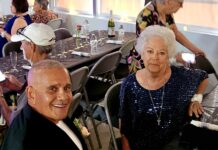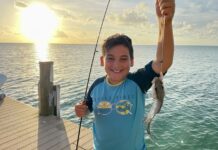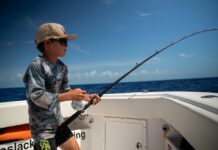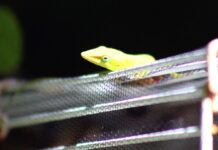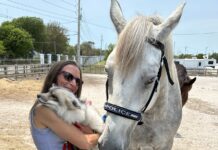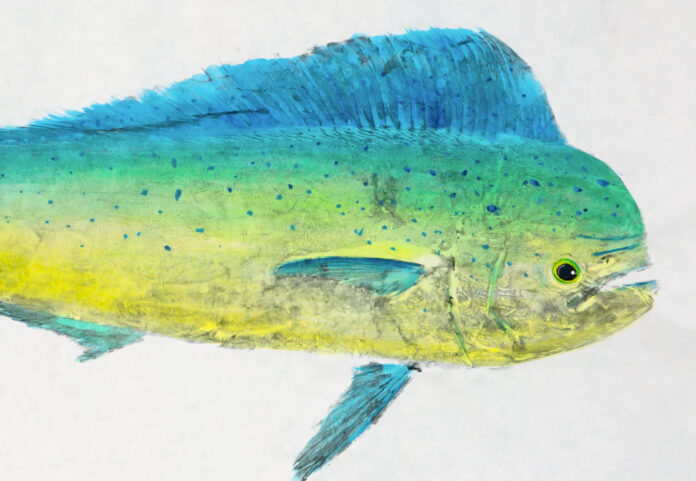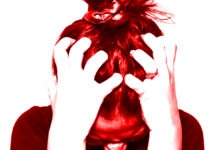A new gallery, “Gyotaku by Lisa Lee,” recently opened in the heart of Islamorada’s art district, 81641 Old Highway, Islamorada, just steps north of the Florida Keys Brewing Co.
“My new gallery will be focused mainly on gyotaku,” she said. “I want people to learn about this incredible form of art when they visit my shop and all that goes into it. It’s my goal to have each visitor leave with a feeling of inspiration and new appreciation for all our species.
“Gyotaku comes from the words “gyo” meaning fish and “taku” meaning rubbing. This type of nature printing began centuries ago with Japanese fishermen as a way to keep record of their catch,” she continued. “I stay close to the traditional methods of this fine art, practicing both traditional sumi ink impressions as well as the takusaikai method where I paint the pigmented paints directly onto the fish and then transfer them to traditional washi paper. Both techniques are incredible methods of gyotaku yet have very different aesthetics and approaches.”
Lee was originally a traditional acrylic artist. Her introduction to the art of gyotaku was in the Keys at a gift shop in the late ’90s. She saw a strikingly real painting of a school of goggle eyes with the small Japanese hanko stamp signature, and that triggered something in her to continue looking into it. She studied what she could find about it from the few books and articles out there, as well as collected pieces from other gyotaku artists in her travels.
She grew up as an avid fisherman between the Keys and Fort Lauderdale. Always comfortable and familiar with all sorts of fish, this trait has come in handy when printing the fish for gyotaku. In 2020, she shifted from her traditional acrylic art and focused on the art of gyotaku. Years of research, practice and dedication had paid off with her gyotaku art.
“My first artist I really fell in love with was Van Gogh; when I first saw Starry Night in a book I immediately connected to it and couldn’t wait to one day see it in person. Which I finally did on my first trip to New York City, went straight to the MOMA (Metropolitan Museum of Modern Art) to sit in front of it for hours.”
Lee is also inspired by Frederic Chopin, whose music gave her a love for piano which will always be a part of her life. She often listened to his etudes while painting. Her recent inspirations for the art of gyotaku are Dwight Hwang, Elena DiCapita and Marc Porrini. This year she traveled to Japan, the birthplace of gyotaku, and studied under Masatsu Matsunaga and other incredible gyotaku masters.

The most challenging part of creating gyotaku is that every species has its own unique challenge.
“For example, some fish are smooth, others have perfect scales, others have interesting rough textures. Each fish also responds differently to the materials. There is an infinite amount of combinations of fish and materials and paints or inks,” she said. “With gyotaku, you are obviously using a real fish, so these organic materials have a finite amount of time to work with before they are sent to the filet table or begin to lose their structure.
“I have to work uncomfortably quickly in order to capture my subjects before anything spoils. I’m also outside for the most part so wind, humidity, sun and light will all affect my work. There is no one set way to do this art. Every time I approach a gyotaku, it will be different depending on the fish, materials and the environment at that moment.”
Lee’s favorite fish to paint is the wahoo.
“They are one of the most beautiful fish in the oceans. Wahoo have incredible layers of blues and stripes and are slightly rarer and more challenging fish to print,” she said. “They are also, in my opinion, one of the most delicious.”
Her favorite part of printing is the reveal of a great print. It doesn’t matter if it is the traditional sumi inks done dockside or takusaikai methods created in the controlled environment of her gallery.
The best part is when she pulls that paper off to reveal the art.
The most unusual fish she has ever printed was just recently caught right here in Marathon.
“It was a royal flagfin caught nearly 700 feet deep — think of a large colorful lizard fish with yellow leopard print spots on its fins and its body like a python.”
Lee said there are countless species in the ocean that are all beautiful and unique in their own way and somehow gyotaku can tell their stories. Although Islamorada will forever be her home base, she will continue traveling the world studying alongside other gyotaku artists while “printing and enjoying all the different species I can get my hands on.”

